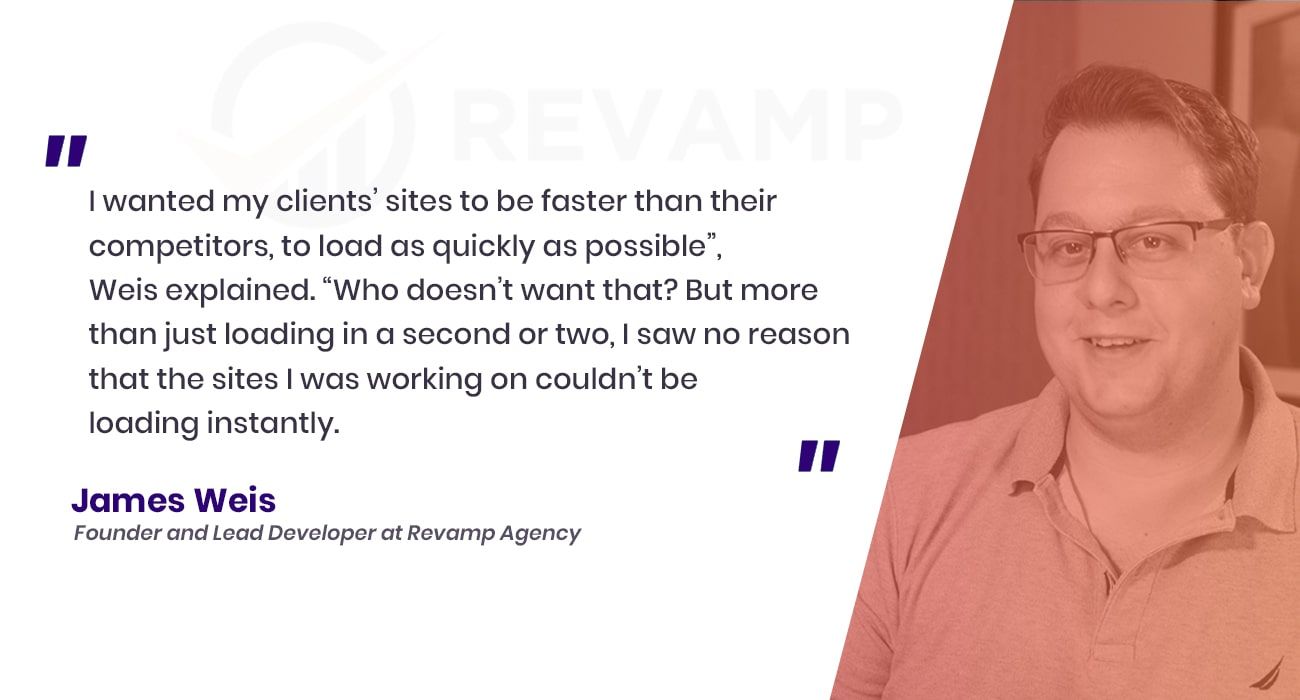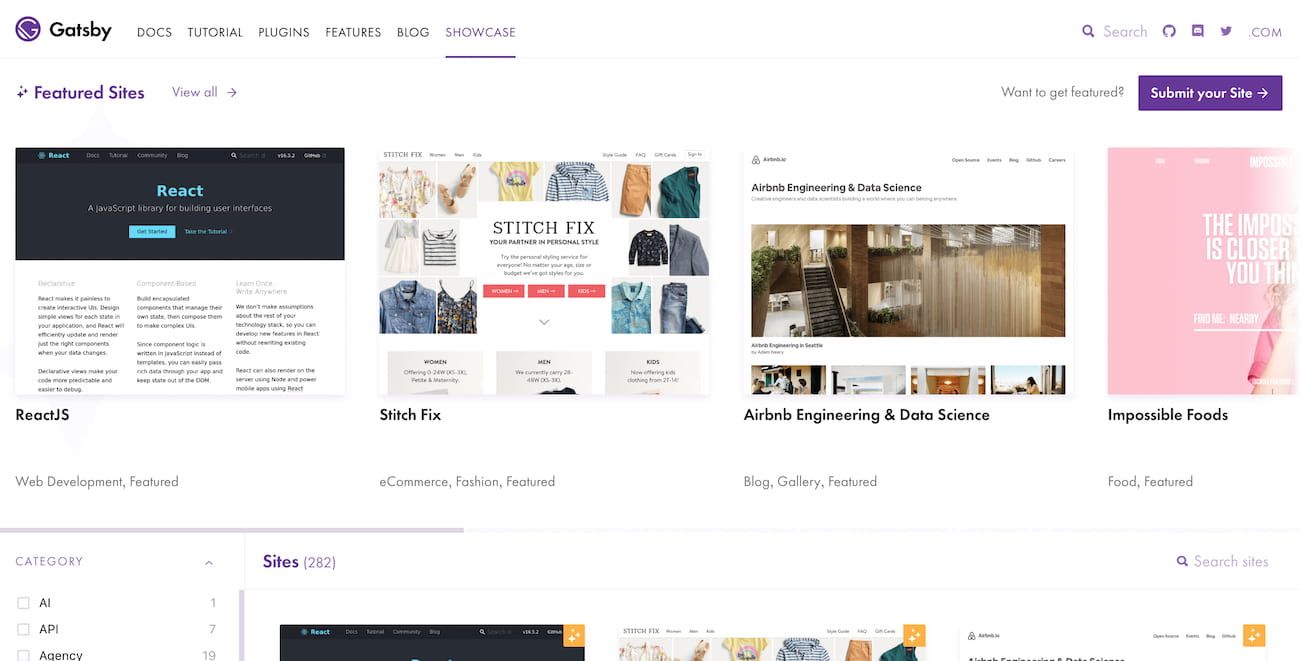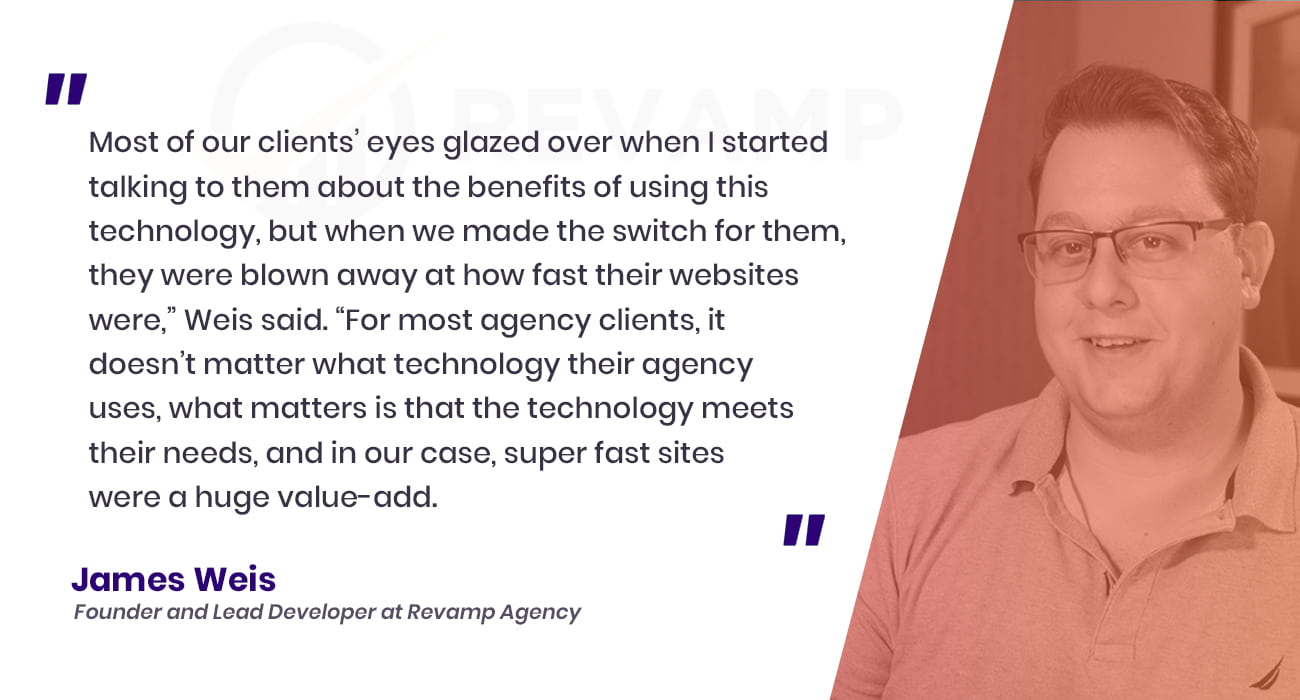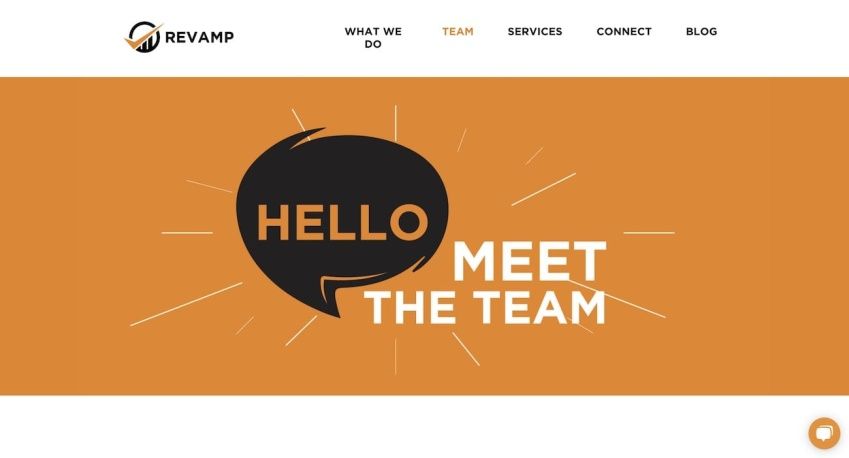- 7 min to read
Case Study: Why NYC-based Revamp Agency Switched from a WordPress Shop to Jamstack
Read the story how Bejamas helped Revamp Agency move from a WordPress shop to Jamstack and delight their customers with fast loading and fully customizable websites.
In the fall of 2017, James Weis, founder and lead developer at Revamp Agency, was looking for a way to help his client’s websites load faster. That July, Google had officially started including site load times and overall speed as factors in determining how to rank them on Google search engine results pages on mobile devices.
Revamp was already using LightHouse, Google’s own PageSpeed report, and a variety of plugins and server-side optimizations to help client sites load quickly, but it wasn’t enough.

The reason for that is that Weis and his team work with mostly small-to-medium sized companies. Most are B2B, some are B2C, but all of the websites Revamp manages - even those with e-commerce integrations and storefronts - are fundamentally very similar and very simple.
All of the sites were built on WordPress - Revamp had been a WordPress shop for several years and, generally, the team and their clients were content with the service. But what Weis and his team found was there was no amount of plugins they could use, and no amount of front-end optimizations they could deploy to get the sites to load as fast as they wanted.
Leveraging CDN’s and optimizing server-side features was equally futile. There seemed to be a ceiling in how fast dynamic WordPress sites like these could load, no matter how simple or straightforward the content was.
This inability to engineer a way to faster load times finally caused Weis and his team to think outside the box they had been comfortable in using the WordPress ecosystem. They started looking for alternative platforms for building and managing their clients’ websites. Luckily for them, there was a brand new alternative available to them.
Join Bejamas newsletter
Get our EXCLUSIVE web development case studies in your mailbox!
Why WordPress Wasn’t Working for Revamp
The loading speed wasn’t the only reason why Revamp was interested in exploring alternatives to WordPress for their clients' sites.
“As we grew and designed, built, hosted, and maintained a larger number of websites for our clients, more and more of our time was spent on monitoring plugins for updates, keeping things up to date and secure. It was honestly taking up hours and hours every month, which just wasn’t making sense financially for the company.” - said Weis.
Weis and his team were also struggling more and more with legacy client sites. Many Revamp customers had been around for years, and while the front-end of their sites had been refreshed and updated, the backends had become complicated and difficult for new account managers and junior marketers on the team to navigate when publishing new content.
This challenge was amplified for those clients, legacy or not, who needed their own access to the CMS and would regularly make updates on their own. Training clients and providing support for them - including when they would accidentally turn off a plugin or break a module - was time-consuming and frustrating, for both the account managers at Revamp and the client.
The template foundation for most of these sites, too, created what Weis felt like was an unnecessary limitation to what his designers could offer clients in terms of updates to the look and feel of their sites. Clients would be bored with a template they see replicated everywhere else, but uncomfortable with a complete custom redesign and rebuild.
Weis struggled with figuring out a way to update existing templates to create a custom, fresh look with writing new code that didn’t slow down the site at all.
“WordPress took over the world of CMS platforms and website design for good reasons, but it had become too cumbersome for our clients, who are looking for continuous design updates to improve bounce rates and conversions, and an easy-to-use interface they can pick up quickly,” Weis said.
To sum up, the key problems Revamp Agency faced with WordPress were:
- Unsatisfying page load speed
- Legacy sites with out-of-date backend solutions
- A need to train and support clients who would access the CMS themselves
- Boring and obviously template looking design
The solution: Jamstack and React-based Gatsby
So last fall, with all of this weighing on him, Weis found out about a new React-based static site generator called Gatsby, which had released a v2 of its software in June 2018.
Gatsby is a React-based, GraphQL powered, static site generator, meaning it includes the best features of React Javascript library, GraphQL, and tools that allow for a completely new front-end web build experience. It’s built on the Jamstack - Javascript, APIs, and markup - and is easily scalable with limited dev-ops overhead costs.

See websites developed with Gatsby
But would static websites work for Revamp clients?
Static site generators have come a long way in the thirty years. While static sites in the 1990s were painfully basic and limited in terms of what features and functionality they could include, modern static sites can be as dynamic as you like - the key difference is not the features or functionality, but how the content is rendered.
Static sites don’t have a database layer under the front-end presentation of content. A static site doesn't need to wait for content to be pulled from databases in order to render a page. Instead, it uses static files to build the site in the browser, only as the viewer accesses the pages - pages not being viewed are not rendered. So your viewers are never waiting for elements at the bottom of a global footer module to load when they are trying to find your phone number on the contact page.
This is an ideal site-building toolset for small-to-medium businesses that are far more interested in getting key information in the hands of potential customers than they are in the complexities afforded sites built dynamically using databases. Pages like About Us, Hours, Contact, or Connect are the most highly visited pages on most websites.

What was it like to switch from WordPress to React based Gatsby?
The Revamp team decided to first redesign and rebuild the agency website in Jamstack Gatsby to test out the process from beginning to end before rolling it out to clients.
The designers enjoyed more freedom in their process. When Weis gave them requirements for functionality and look and feel of the new Revamp site, they weren’t restricted to design limitations of specific modules or plug-in features that they knew the developers would need to build in to get that functionality.

The build itself was also simple, though that was in a large part because Weis was already familiar with Javascript and took the time to teach himself React and GraphQL - that step was critical. But once he got the hang of the code, the development work was straightforward and again, without the limitations of a clunky CMS platform like WordPress to consider.
“It was our first site, so we very much enjoyed the design process, and then things slowed down as I learned my way around the code,” Weis said. “Once I did, though, I was able to build from scratch everything exactly as I wanted it to be, which was amazing.”
For the Revamp site, Weis did not build in a custom CMS or leverage many of the available Jamstack CMS tools - it was faster to launch that way. Of course, that meant post-launch edit requests had to go through him, which was time-consuming at first, but not having a CMS hooked up could be a value add for some clients.
“Since our time to launch without including a CMS was much faster, for those clients who have no interest in logging into the back-end of their site at all, we can deliver a new website to them much quicker than usual and then manage edits using our in-house development team,” Weis said.
In addition, Weis found it very simple to hook the site up to a CMS - Revamp chose DatoCMS as their first Gatsby CMS - a few months after the site was finished when the team had time. Switching out CMS as clients request it is also simple to do with a Gatsby site, making content management much more flexible for clients.
Hiring an in-house developer vs working with a dedicated Jamstack and Gatsby developer agency
After launching the new Revamp website, the team had a decision to make: start rolling out new site builds for clients leveraging in-house development staff, or hire a dedicated, third-party Gatsby dev-shop to help out.
“It was beneficial to spend time training up internally on the technology,” Weis said, “but the decision to outsource the work was a no-brainer for me.”
The Revamp team’s core competencies are the design process - turning client goals and visions into graphics, art, fonts, and copy. Each member of the team has a hyper-specific skill to deliver world-class designs for clients.
A Jamstack website development agency has its own team members with hyper-specific skill sets that the Revamp team could leverage immediately, without waiting to train up internal team members. It’s impossible, as every agency knows, to find one or two developers that have all the skills the agency could need to build and maintain websites for clients. A dedicated development agency can draw from much broader resources to meet whatever challenge comes in the door next faster and easier.
While other agencies might choose to hire internally rather than outsource development work, Revamp is happy with the choice. The team can focus on designs with their clients, and move faster to bring the benefits of the Jamstack and Gatsby to more of their current and prospective clients thanks to a full team of developers ready to work with them.
Any business can benefit from building a site on the Jamstack
Every business can benefit from a website, but sites that are slow, clunky, and difficult to manage or update can do more harm than good. Consumers trust the business with clean, faster, professional websites that convey the brand and voice of a company. If a website takes too long to load, consumers will bounce off a domain, looking to do business with companies that take their web presence seriously and make it easy for them to get the information they need.
The Jamstack and site generators like Gatsby are the future of the web and doing business online - nothing compares to the speed and simplicity of building a site with Gatsby.
Have a project at hand that is perfect for Jamstack? We can help in that regard.
CLICK HERE to schedule a 1-on-1 talk and learn more about what we can do for you and your business.